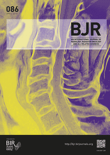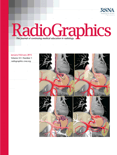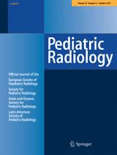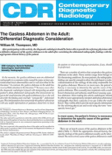
BRITISH JOURNAL OF RADIOLOGY
Scope & Guideline
Shaping the Future of Imaging through Rigorous Research
Introduction
Aims and Scopes
- Radiological Imaging Techniques:
BJR publishes research on a wide array of imaging modalities including MRI, CT, ultrasound, and PET, focusing on their applications in diagnosing and monitoring various diseases. - Interventional Radiology:
The journal features studies on interventional techniques, discussing advancements in procedures such as cryoablation, radioembolization, and minimally invasive therapies. - Machine Learning and Artificial Intelligence:
There is a significant focus on the integration of AI and machine learning in radiology, exploring its potential to enhance diagnostic accuracy, automate processes, and improve patient outcomes. - Radiomics and Imaging Biomarkers:
BJR emphasizes the role of radiomics in extracting quantitative features from imaging data to predict clinical outcomes, treatment responses, and prognostic factors for various cancers. - Clinical Guidelines and Best Practices:
The journal provides insights into clinical guidelines, quality assurance measures, and best practices for radiological services, aiming to standardize and improve care in radiology. - Education and Training in Radiology:
BJR addresses the educational aspects of radiology, including training methodologies, curriculum development, and the impact of new technologies on radiology education.
Trending and Emerging
- Artificial Intelligence and Machine Learning:
There is a notable increase in studies exploring the application of AI and machine learning in radiology, including their use for image analysis, diagnostic support, and workflow optimization. - Radiomics and Precision Medicine:
Research focusing on radiomics, which utilizes quantitative imaging features to inform treatment decisions and prognostic assessments, has gained significant traction, reflecting a shift towards precision medicine. - Hybrid Imaging Techniques:
The rise of hybrid imaging modalities, such as PET/MRI and PET/CT, is evident, as these techniques provide comprehensive diagnostic information and enhance patient management. - Patient-Centric Radiology:
Emerging themes highlight the importance of patient-centered approaches in radiology, focusing on improving patient experiences, safety, and outcomes. - Sustainable Imaging Practices:
There is an increasing focus on sustainability in radiology, emphasizing the need for reducing radiation exposure and optimizing resource use in imaging practices. - Interventional Radiology Innovations:
The journal has seen a rise in publications related to innovative interventional radiology techniques, showcasing advancements in minimally invasive procedures and their clinical applications.
Declining or Waning
- Traditional Imaging Techniques:
There appears to be a waning interest in conventional imaging techniques, such as basic X-rays and standard ultrasound, as more advanced modalities like MRI and CT gain favor due to their superior diagnostic capabilities. - Basic Radiological Education:
The emphasis on traditional radiological education has decreased as more focus is placed on advanced imaging technologies and AI integration within the curriculum. - Epidemiological Studies:
Research centered on purely epidemiological aspects of radiology has become less frequent, likely due to a shift towards more applied clinical research and technology-driven studies. - Non-invasive Imaging Biomarkers:
The exploration of non-invasive imaging biomarkers has seen a decrease, with greater attention now being paid to quantitative imaging and radiomics. - General Radiology Topics:
There is a decline in publications focusing on broad, general topics in radiology, as studies become more specialized and targeted towards specific diseases or advanced imaging techniques.
Similar Journals

Iranian Journal of Radiology
Advancing Radiology Through Innovative ResearchWelcome to the Iranian Journal of Radiology, a pivotal platform dedicated to advancing the field of radiology, nuclear medicine, and medical imaging. Published by BRIEFLAND, this journal aims to disseminate high-quality original research, reviews, and clinical studies that contribute substantially to the global scientific community. Established in 2008 and spanning until 2024, the journal provides an essential archive of knowledge in a rapidly evolving discipline. Although it currently holds a Q4 quartile ranking in the 2023 Scopus metrics, it serves as an important resource for both emerging and established researchers looking to submit their work. Located in the Netherlands, the journal is committed to open dialogue and collaboration amongst professionals in the field, reflecting its accessibility and relevance to both practitioners and academics. With its continued growth and commitment to quality, the Iranian Journal of Radiology is poised to enhance understanding and innovation in diagnostic imaging.

RADIOGRAPHICS
Empowering Radiologists with Cutting-edge ResearchRADIOGRAPHICS, published by the Radiological Society of North America (RSNA), is a premier academic journal dedicated to the field of radiology, nuclear medicine, and imaging. With an impressive impact factor and recognition in the top quartile (Q1) of both Medicine (miscellaneous) and Radiology, Nuclear Medicine and Imaging categories, RADIOGRAPHICS stands out as a leading platform for disseminating high-quality research and clinical findings. Since its inception in 1985 and projected to run until 2024, the journal has consistently provided essential insights into cutting-edge imaging techniques and advancements in radiological practices, making it invaluable for professionals, researchers, and students alike. Although it does not offer open access, the journal continues to flourish with a robust reputation, ranked 35th in its field according to Scopus, placing it within the 89th percentile of its category. With an unwavering commitment to enhancing the understanding and application of radiological sciences, RADIOGRAPHICS remains a pivotal resource for advancing knowledge and expertise within the medical community.

Insights into Imaging
Elevating Standards in Radiology and Nuclear MedicineInsights into Imaging is a prominent open-access journal published by SPRINGER WIEN, specializing in the dynamic fields of radiology, nuclear medicine, and imaging, with its ISSN 1869-4101. Established in 2012, the journal has established itself as a leading platform for disseminating high-quality research and innovative findings, currently holding a prestigious Q1 ranking in its category as of 2023. With an impressive Scopus rank of #42 out of 333 in the medicine discipline, the journal is positioned in the 87th percentile, reflecting its significance and influence in the academic community. Based in Germany, Insights into Imaging not only provides unrestricted access to research but also aims to bridge the gap between scientific inquiry and clinical application, making it an essential resource for researchers, professionals, and students engaged in advancing imaging technologies and practices. The journal’s commitment to fostering knowledge exchange ensures that it remains a critical contributor to the evolving landscape of medical imaging, with articles available from 2012 through 2024.

PEDIATRIC RADIOLOGY
Enhancing diagnosis and treatment in pediatric medicine.Pediatric Radiology is a leading journal published by Springer that provides a crucial platform for the dissemination of research in the fields of pediatrics, perinatology, and radiology. Since its inception in 1973, the journal has continually contributed to the advancement of medical imaging techniques and their application in diagnosing and treating pediatric conditions. With its impact factor reflecting a Q2 ranking in both Pediatrics and Radiology categories as of 2023, Pediatric Radiology is highly regarded in scholarly circles, aiding researchers, clinicians, and students to stay at the forefront of innovations and findings in the field. Although the journal does not offer open access, it continues to be an essential resource for evidence-based information that enhances clinical practice and improves health outcomes for children globally. The journal's reach is further established through its solid Scopus rankings, indicating its relevance and influence in the global medical community.

Radiologia Medica
Unveiling the Future of Medical Imaging Techniques.Radiologia Medica, published by Springer-Verlag Italia SRL, is a premier Italian journal dedicated to the field of radiology, nuclear medicine, and imaging. With a rich history dating back to 1947, this journal has consistently provided cutting-edge research and findings, contributing significantly to advancements in medical imaging techniques and practices. As evidenced by its impressive Q1 rankings in both Medicine (Miscellaneous) and Radiology, Nuclear Medicine and Imaging, Radiologia Medica holds a prestigious position within the top tier of medical journals, ranked #11 out of 333 in its category and residing in the 96th percentile according to Scopus metrics. Although it is not currently offered as an Open Access journal, its robust subscription model supports extensive research dissemination. Researchers, professionals, and students alike will find invaluable insights and knowledge critical for advancing their understanding and practice within this dynamic field. Situated in Milan, Italy, Radiologia Medica continues to be an influential platform for the exchange of high-quality research, bridging various disciplines and promoting excellence in radiological science.

EUROPEAN RADIOLOGY
Exploring Innovations in Diagnostic ImagingEUROPEAN RADIOLOGY, published by SPRINGER, stands as a prestigious international journal in the field of radiology, nuclear medicine, and imaging, with an impressive impact factor that underscores its significance among peers. With an ISSN of 0938-7994 and an E-ISSN of 1432-1084, this journal provides a platform for cutting-edge research and advancements in medical imaging from 1991 to 2024. Recognized as a Q1 journal in both general Medicine and the specialized Radiology category by 2023, EUROPEAN RADIOLOGY ranks an impressive #17 out of 333 in its field according to Scopus, placing it in the 95th percentile. While it does not currently offer Open Access options, the journal remains essential reading for researchers, professionals, and students striving to stay at the forefront of developments in diagnostic imaging and related technologies. By contributing to a comprehensive understanding of radiological practices, EUROPEAN RADIOLOGY plays a crucial role in shaping the future of medical diagnosis and patient care.

Applied Radiology
Nurturing Knowledge in Nuclear Medicine and ImagingApplied Radiology, an esteemed journal published by Anderson Publishing, Inc., has been a significant contributor to the field of radiology since its inception in 1973. With a focus on innovative imaging techniques and their application in clinical practice, this journal serves as an invaluable resource for researchers, healthcare professionals, and students aiming to stay at the forefront of advancements in radiology, nuclear medicine, and imaging. Applied Radiology holds a Q4 quartile ranking in the category of our field, indicating its niche yet essential role in disseminating knowledge and fostering dialogue among radiologists. The journal operates primarily under subscription access, ensuring a curated access to publications that reflect the dynamic nature of research and technology in radiology, particularly up to the year 2024. As it continues to guide the future of radiological practices, Applied Radiology remains dedicated to delivering high-quality, peer-reviewed content that supports ongoing education and clinical excellence.

Radiologie
Elevating Clinical Practice with Radiological InsightsRadiologie, published by SPRINGER HEIDELBERG, is an emerging journal dedicated to the fields of radiology, nuclear medicine, and imaging. With an ISSN of 2731-7048 and E-ISSN 2731-7056, this journal does not currently offer open access, providing a traditional yet respected platform for scholarly communication. Founded in 2022, it aims to advance the understanding of cutting-edge imaging techniques and their applications in clinical practice, contributing to improvements in diagnostic accuracy and patient care. Despite its recent establishment, Radiologie is positioned within the Q4 quartile category, reflecting its developing presence in the academic landscape, with a current Scopus rank of #231 out of 333 in its category. The journal serves as a vital resource for researchers, professionals, and students seeking to stay abreast of the latest developments in radiological science, imaging technology, and their clinical implications, ensuring ongoing engagement and advancement in this critical area of healthcare.

Current Radiology Reports
Unlocking the future of imaging and nuclear medicine.Current Radiology Reports is an esteemed journal published by SPRINGERNATURE, focusing on the dynamic field of radiology, nuclear medicine, and imaging. With a commitment to advancing knowledge and promoting innovative practices, this journal serves as a valuable resource for researchers, healthcare professionals, and students striving to stay at the forefront of radiological advancements. Featuring an impressive impact factor and recognized as a Q3 journal within its category as of 2023, it highlights critical developments and comprehensive reviews that inform clinical practice and research methodologies. Although it operates under a subscription model, the journal provides a rich repository of peer-reviewed content, covering a wide range of topics from diagnostic imaging to therapeutic applications. With a publication span from 2013 to 2024, Current Radiology Reports continues to uphold its reputation as a leading publication critical for anyone involved in the radiology profession.

Contemporary Diagnostic Radiology
Shaping the Landscape of Radiological ScienceContemporary Diagnostic Radiology is a pivotal journal in the field of medical imaging and radiology, published by Lippincott Williams & Wilkins. With an ISSN of 0149-9009 and an E-ISSN of 1938-1395, this journal serves as an essential platform for disseminating high-quality research and advances in diagnostic radiology and related disciplines. While it is categorized in the lower quartiles (Q4) for its performance in the 2023 rankings in both Neurology, Radiology, Nuclear Medicine and Imaging, and Surgery, its focus on emerging technologies and methodologies in imaging continues to provide valuable insights for practitioners and researchers alike. The journal’s scope includes innovative diagnostic tools, imaging techniques, and case studies, fostering collaboration and knowledge sharing in the medical community. Although it does not offer open access options, its commitment to contributing to the ongoing dialogue in clinical imaging is undisputed, making it an essential resource for professionals seeking to stay abreast of current trends and research in the rapidly evolving landscape of diagnostic radiology.